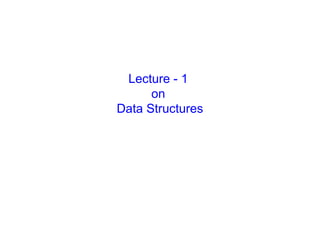
Data structure lecture 1
- 1. Lecture - 1 on Data Structures
- 2. Data Type and Data Structure Data type •Set of possible values for variables •Operations on those values Ex : int, float, char ………. Data Structure A data structure is an arrangement of data in a computer's memory or even disk storage. The logical and mathematical model of a particular organization of data is called a data structure. A data structure is a particular way of storing and organizing data in a computer so that it can be used efficiently.
- 3. An example of several common data structures: • arrays, •linked lists, •stacks, •queues, • trees, •and Graph
- 5. Array Linear array (One dimensional array) : A list of finite number n of similar data elements referenced respectively by a set of n consecutive numbers, usually 1, 2, 3,…..n. That is a specific element is accessed by an index. Let, Array name is A then the elements of A is : a1,a2….. an Or by the bracket notation A[1], A[2], A[3],…………., A[n] The number k in A[k] is called a subscript and A[k] is called a subscripted variable. element
- 6. Example A linear array STUDENT consisting of the name of six students STUDENT 1 Dalia Rahaman 2 Sumona 3 Mubtasim Fuad 4 Anamul Haque 5 Ibtisam Rahaman 6 Jarin Here, STUDENT[4] denote Anamul Haque
- 7. Array (con…) Linear arrays are called one dimensional arrays because each element in such an array is referenced by one subscript. (Two dimensional array) : Two dimensional array is a collection of similar data elements where each element is referenced by two subscripts. Such arrays are called matrices in mathematics and tables in business applications. Multidimensional arrays are defined analogously MATRICES 1 2 3 4 1 1 2 3 4 Here, MATRICES[3,3]=11 2 5 6 7 8 3 9 10 11 12 4 13 14 15 16
- 8. Array Data Structure It can hold multiple values of a single type. Elements are referenced by the array name and an ordinal index. Each element is a value Indexing begins at zero. The array forms a contiguous list in memory. The name of the array holds the address of the first array element. We specify the array size at compile time, often with a named constant.
- 9. Linked lists •A linked list, or one way list, is a linear collection of data elements, called nodes, where the linear order is given by means of pointers. •Dynamically allocate space for each element as needed. Node Data Next In linked list Each node of the list contains the data item a pointer to the next node Collection structure has a pointer to the list Start Initially NULL Start Prepared by, Jesmin Akhter, Lecturer, IIT,JU
- 10. Linked lists Start node node Data Next Data Linked list with 2 nodes Prepared by, Jesmin Akhter, Lecturer, IIT,JU
- 11. Linked lists INFO LINK START 1 START=3, INFO[3]=M 3 2 A 5 LINK[3]=2, INFO[2]=A 3 M 2 LINK[2]=5, INFO[5]=N LINK[5]=4, INFO[4]=G 4 G 7 LINK[4]=7, INFO[7]=O 5 N 4 LINK[7]=0, NULL value, So the list has ended 6 7 O 0 8
- 12. Stacks • Stacks are a special form of collection with LIFO semantics • Two methods - add item to the top of the stack - remove an item from the top of the stack • Like a plate stacker
- 13. Queues • Like a stack, a queue is also a list. However, with a queue, insertion is done at one end, while deletion is performed at the other end • The insertion end is called rear – The deletion end is called front Remove Insert front rear
- 14. edges
- 17. Data structure operations The data appearing in our data structure is processed by means of certain operations. In fact, the particular data structure that one chooses for a given situation depends largely on the frequency with which specific operations are performed. The following four operations play a major role: Traversing Accessing each record exactly once so that certain items in the record may be processed. (This accessing or processing is sometimes called 'visiting" the records.) Searching Finding the location of the record with a given key value, or finding the locations of all records, which satisfy one or more conditions. Inserting Adding new records to the structure. Deleting Removing a record from the structure.
- 18. Data structure operations (Continued) The following two operations, which are used in special situations, will also be considered: Sorting: Arranging the records in some logical order Merging: Combining the records in two different sorted files into a single sorted files
- 19. Algorithms An essential aspect to data structures is algorithms. Data structures are implemented using algorithms. An Algorithm is a finite step – by – step list of well defined instructions for solving a particular problem. It is used to manipulate the data contained in the data structures as in searching and sorting. It states explicitly how the data will be manipulated. Perform data structure operations
- 20. Complexity The complexity of an algorithm is a function describing the efficiency of the algorithm in terms of the amount of data the algorithm must process. There are two main complexity measures of the efficiency of an algorithm: Time complexity is a function describing the amount of time an algorithm takes in terms of the amount of input to the algorithm. Space complexity is a function describing the amount of memory (space) an algorithm takes in terms of the amount of input to the algorithm.
- 21. Discussion •Once data is organized into forms such as trees, stacks and queues, standard algorithms can be used to process them. •Properly organized data lead to easy-to understand user interfaces
